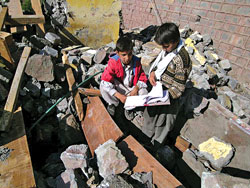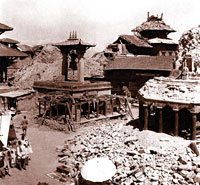 It all started with Ali Hamza and his soon-to-be wife tirelessly nagging me over the Kashmir earthquake issue. Though I was never into community service, I felt obliged to go there and do my part working for a good cause.
It all started with Ali Hamza and his soon-to-be wife tirelessly nagging me over the Kashmir earthquake issue. Though I was never into community service, I felt obliged to go there and do my part working for a good cause.
With serious doubts on my mind, I set off on 28 December for Muzaffarabad, one of the cities hit hardest by the 8 October quake. I was expecting a city of ruins, a dead city. But when I arrived I was surprised to find Muzaffarabad functioning like any other small Pakistani city.
It was when I started searching for a place to stay that I got my first glimpse of reality-most of the moderate hotels had not survived the quake.
I was supposed to get in touch with Hasif, a Muzaffarabad-based aid worker who also had a strong religious inclination. He was not around so to kill time I took a stroll around the city. The situation seemed desperate as people waited for promised aid to materialise. Rs 175,000 pledged by the Pakistan government to those whose houses had been destroyed had already been cut to only Rs 25,000 but even that had not been distributed.
A storekeeper told me, "Bhai jaan, this government was supposed to compensate us but with that amount it will be impossible to rebuild our houses." Finally Hasif showed up and he seemed to get more disgruntled with every passing day. "The UN cars don't move without any escort- around 300 Pakistani soldiers have been assigned just to protect them when there is a shortage of manpower to help in reconstruction. Even if they do rebuild, it is only the army barracks while the public offices and schools lie in ruins," he said.
 He warned me that corrupt local authorities were raising funds for their own political campaigns that would take place later. "You will find them at checkpoints, be very cautious of them. Act foreigner, jumble up English and Urdu then they will let you pass," he said.
He warned me that corrupt local authorities were raising funds for their own political campaigns that would take place later. "You will find them at checkpoints, be very cautious of them. Act foreigner, jumble up English and Urdu then they will let you pass," he said.
Though downtown Muzaffarabad looked normal, a half hour walk to the outskirts proved that it was hard hit. Refugee camps of about 300 tents had been set up, where eight to 10 people crowded into a single dwelling. Drinking water and food was transported from the city but blankets were in short supply and the tents were scant protection against the cold winter wind.
Though winter had yet to arrive in full force, people were apprehensive about the coming months of snow and intense cold. It was estimated that at least 30 percent of those tent refugees would not survive.
Another problem facing the survivors was that though the Pakistani army had started distributing cheques for Rs 25,000, people were unable to cash them. The banks would demand identity but for people who had lost everything in the quake this was impossible to produce. "We have faith in Allah, he has already saved us once and if so is his will, he will save us again," said Aftab Hussain, 23, who lived in a tent with his three sisters and five brothers.
As I walked away from that devastation, inadequate government response and official corruption, I wondered what the results would be should such an incident occur in Kathmandu, where the houses are packed in like sardines. Nepal has been warned time and again about an impending killer quake but few of us have even started preparing. Should the dreaded happen, would we be in the same situation.or worse?
Asim Singh Mahat just graduated from The University of Engineering and Technology in Lahore
72 years ago this week
 It was a sunny winter afternoon with bright blue sky and a slight breeze from the west. Most families in Kathmandu were relaxing on their rooftop terraces or at work in the fields. It was 1.30 PM on 15 January 1934. Suddenly, birds took flight and dogs started howling. There was a deep underground rumble, the surface of Tundikhel started undulating like ocean waves. Temples crumbled, long fissures appeared on the roads and a great pall of dust rose up over the city. Mangal Bajar was in ruins (see picture).
It was a sunny winter afternoon with bright blue sky and a slight breeze from the west. Most families in Kathmandu were relaxing on their rooftop terraces or at work in the fields. It was 1.30 PM on 15 January 1934. Suddenly, birds took flight and dogs started howling. There was a deep underground rumble, the surface of Tundikhel started undulating like ocean waves. Temples crumbled, long fissures appeared on the roads and a great pall of dust rose up over the city. Mangal Bajar was in ruins (see picture).
Within a minute, 17,000 people were dead in Kathmandu, the adjoining hills and the plains of northern Bihar. Among the dead were two of King Tribhubhan's daughters and a daughter of Juddha Shumshere. Most houses were destroyed or damaged in the 8.0 magnitude earthquake. Aftershocks terrified survivors camped out in the freezing cold for the next month.
What is frightening to many is not the memory of that fateful day 70 years ago but what will happen the next time an earthquake of that magnitude hits Kathmandu. The Nepal Bihar faultline is said to snap every 75 years, making us due for the next disaster.
The Kashmir earthquake of 8 October that killed over 80,000 people in Pakistan and India showed us the kind of energy that is released in great Himalayan earthquakes. It left four million homeless and over 100,000 injured. With its 'seismic gap', western Nepal, where no major earthquake has happened for over 250 years, is ripe for one. Given Kathmandu's rampant growth and flimsy housing, experts predict the next big one will kill at least 100,000 people in Kathmandu Valley alone. Those who die may be the lucky ones.


